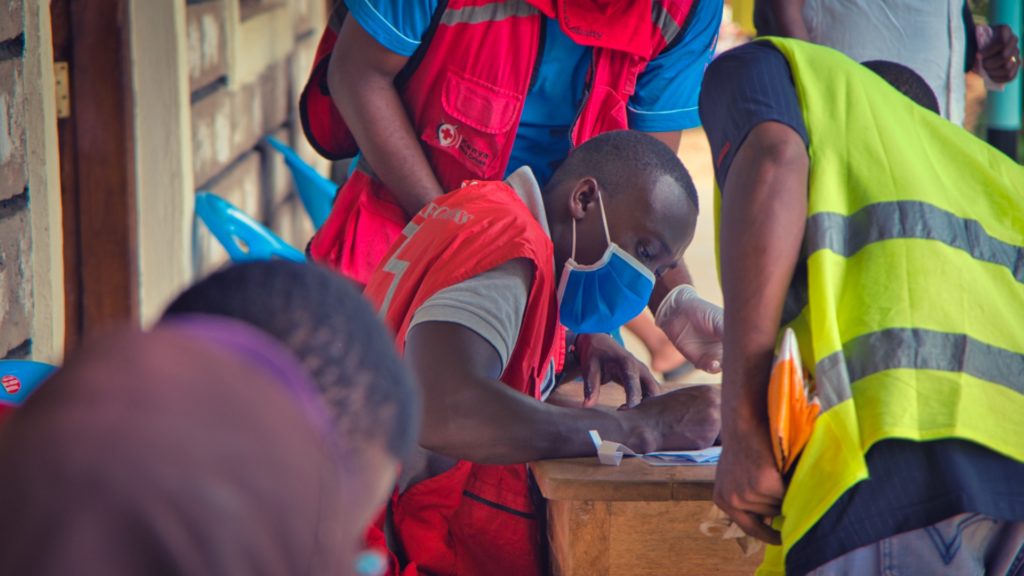Early in the morning we meet the Sub County Administrator and drive together with him to our today’s distribution point – the Diani Vocational Centre. We are in a village called Mvumoni, which also includes Mwakamba and Makieni. Probably most of you will not be able to identify this village.
This is the area called “northern Diani Beach”. If you drive from Ukunda towards Diani Beach, turn left at the T-junction. Mvumoni covers the whole area from this junction up to the Kongo River, which is actually called Mwachema River. The Mwachema River separates our kilometre long white sandy beach at the south coast of Kenya: it marks the border between Tiwi Beach and Diani Beach.
The Mwachema River is always worth a little excursion. Its water flows into the Indian Ocean, forming a beautiful small river delta, where the shining white sand beach is shaped into a picturesque sand landscape by the inflow of the river and the return of the Indian Ocean.
The Kongo Mosque is also located at this delta. This is said to be the oldest mosque in East Africa and it is said to have been built and used for prayers by early Persian merchants when they travelled the east coast in the 14th century. Huge baobab trees make the place between the mosque and the small delta a worthwhile destination. Especially in the late afternoon the light makes the place almost mystical. You will not find any beach bars or restaurants here either. The place around the mosque is considered holy and therefore protected. For many years the mosque was buried under plants until it was rediscovered about 300 years ago. It got its name from a believer who is said to be buried there: Swaddiq Kongo. The mosque was named after him and the Mwachema River is also popularly called Kongo River.
Canoes can be hired to be paddled up the river from its estuary on the Indian Ocean. You will pass Mwakamba, a village that also belongs to Mvumoni. The local guides will take you to their village and tell you about the life of the people. You can also visit the Hermann Nursery/Primary School, a school project initiated by Germans. The river itself is a paradise for nature lovers and bird watchers. The mangrove lined riverbanks are a paradise for birds. Even pelicans, ibises and storks can be discovered.
The other part, which belongs to the Mvumoni administrative unit, is perhaps better known to some: White House. Here you can find a few bars and restaurants and many of the people who are normally employed in direct or indirect tourism have rented small accommodation here. So today we meet many faces we know from hotels, restaurants, bars and nightlife.
We are again supported by the team of the Kenya Red Cross, which takes care of the adherence to the hygiene guidelines and handles the distribution list. Also the Diani Municipality Manager is again present at the distribution. We are once again very happy about the list, which we were able to check in advance. It contains many, many names from all parts of Kenya. Very often we are confronted with the accusations that people who are not from the coast were not taken into consideration when the lists were drawn up. With a total of 730 parcels, we can definitely not confirm this. We really have the impression that the lists were drawn up according to need and not according to tribal affiliation.
Today there was a lot to haul. Although we have a few packages less than in our last distribution, the distance from the truck to the school rooms is much longer. A respectable 6.4 tons have to be transported on the shoulders of our hard-working helpers. Since the truck cannot hold all the packages at once, it has to return to our camp at Diani Sea Lodge to be filled a second time. Then the small misfortune happens. Due to the rain of the last days the ground is very muddy and the truck is stuck. But Pamoja has the idea of solidarity and so there are soon a dozen people who push the truck from Shree Green Grocers Mini Market according to the spirit of Diani Pamoja (together).
The Red Cross is again working with 4 tables to ascertain the identity of all those receiving help. This is a somewhat lengthy process, but it is all the more important in these times when so many households need support. It would be a pity if, due to bad organisation, some households are left empty-handed, while others are considered twice or even more. But as long as all organizations strive to cooperate with the Kenya Red Cross and coordinate with the government as it is required at the moment, this should not happen!
Due to the parallel work at the 4 tables, the distribution goes quickly and smoothly.
Nevertheless, all helpers and also the team of the Red Cross are exhausted around noon. It was exhausting, but again very rewarding. And we are all a little affected by the Diani Pamoja fever.

























